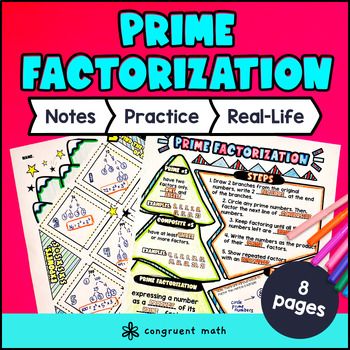Want more ideas and freebies?
Get my free resource library with digital & print activities—plus tips over email.
Join for free resources →
$3.99
Ever wondered how to teach prime factorization to 4th and 5th graders?
Use this artistic, real-life lesson plan to teach your students about prime factorization. Students will learn material with artistic guided notes (like sketch notes), practice and check for understanding with a doodle and color by number activity, and a maze worksheet.
The lesson culminates with a real-life application of how prime factorization powers the cryptography that keeps your data safe every time you swipe your credit card, buy something online, or tell a secret with a messaging app.

$3.99
After this lesson, students will be able to:
Note: This lesson plan only includes practice with 2 and 3 digit numbers. See extensions for practice with longer numbers.
Before this lesson, students should be familiar with:
A fun, no-prep way to practice prime factorization is our Prime Factorization with Exponents Doodle & Color by Number activity (sold separately) — it's a fresh take on color by number or color by code. It includes three levels that help students practice finding the factors of 2-, 3- and 4-digit numbers. Each answer unlocks patterns that they can doodle onto an image.
There's also a special Earth Day version of the activity (sold separately), perfect for spring.
Prime numbers have two factors only: 1 and itself.
Composite numbers have at least 3 or more factors. They can be divided evenly by at least one integer besides 1 or itself; for instance, 4 can be divided into smaller integers: 8 ÷ 2 = 4, so 4 is not a prime number because it can still be reduced further into smaller numbers.
Prime factorization is the process of expressing a number as a product of its prime factors.
Here's an example of prime factorization: 12 = 2 x 2 x 3.
Prime factorization is also known as prime decomposition.
Cryptography is the practice of secure communication in the presence of third parties. It involves creating mathematical algorithms that can be used to encrypt and decrypt messages, making them unreadable to anyone who does not have the key to unlock them.
Prime factorization is used for finding the least common denominator, solving problems in probability, and powering cryptography:
Prime factorization is truly the backbone of our modern society.
Students can compute prime factorization by creating a factor tree. For students that need a visual walk through, I find this Khan Academy video helpful:
Here's the steps to create a factor tree:
I always circle the prime number at the endpoint so that it's clear when I've stopped.
Here's some examples that you can walk through with your students:
24 = 2 x 2 x 2 x 3
36 = 2 x 2 x 3 x 3
48 = 2 x 2 x 2 x 2 x 3
72 = 2 x 2 x 2 x 3 x 3
100 = 2 x 2 x 5 x 5
The prime factorization of a number includes only the prime numbers that are multiplied together to get the original number. Any non-prime factors such as 0, 1, composite numbers are not included in the prime factorization.
Prime factorization is written in the form of prime numbers multiplied together to get the original number. For example, the prime factorization of 24 is 2 × 2 × 2 × 3, and the prime factorization of 100 is 2 × 2 × 5 × 5.
This can be condensed using exponent form, where the prime factorization of 24 can be written as 2³ × 3, and the prime factorization of 100 can be written as 2² × 5². This condensed form is useful for calculations involving large numbers.
Get my free resource library with digital & print activities—plus tips over email.
Join for free resources →